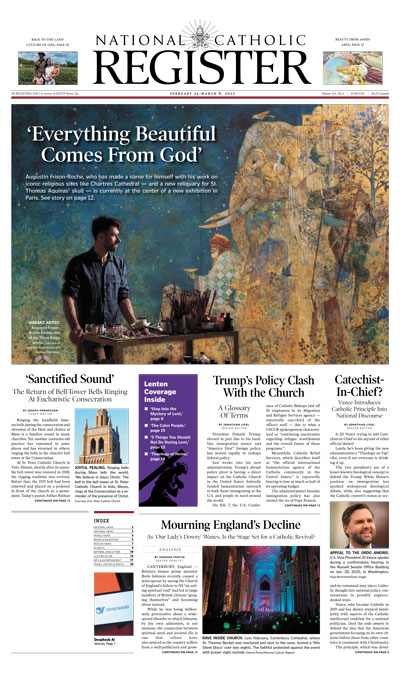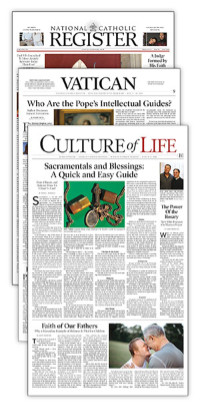Edward Pentin: Tension Mounts as Conclave Approaches
Cardinals who engaged with the media Monday spoke only in the most general terms about the sort of pope they’re looking for. ‘There’s no rush for the white smoke; we have time,’ one said.

VATICAN CITY — With just a few hours until the conclave, the atmosphere in Rome Monday had reached fever pitch, with a rumor mill in full swing and just a few cardinals offering the occasional glimpse into what they are thinking and expecting.
Soon after dawn on May 5, several cardinals began to emerge along the streets as they walked rather than drove to their penultimate day of General Congregation discussions in the New Synod Hall.
As they did so, and as has happened almost every morning since the daily meetings began soon after Pope Francis’ death, a gaggle of reporters and photographers descended on them in the hope of obtaining a few images and morsels of information.
Cardinal Christoph Schönborn, archbishop emeritus of Vienna, smiled as he slowly but determinedly plowed his way through, refusing to answer any questions as he went. Cardinal Stephen Chow of Hong Kong did the same, but walked faster, deftly avoiding the press scrum as we struggled to keep up with his brisk pace.
But a few porporati stopped to offer some clue as to their hopes and expectations.
“How long will the conclave last?” a reporter asked Cardinal Louis Raphael Sako, patriarch of Baghdad of the Chaldeans. “We hope about three to four days,” the Iraqi cardinal replied as he slowly made his way through, along the perimeter of the Bernini Colonnade. What kind of pope was he looking for? “A pastor who looks to the unity and integrity of the Church,” he quietly replied as he continued to walk.
“We don’t have a name yet, we’re just discussing,” said Cardinal Joseph Coutts, the archbishop emeritus of Karachi, Pakistan. “During the congregations, we’re getting to know each other.”
Cardinal Ignatius Suharyo Hardjoatmodjo, archbishop of Jakarta, Indonesia, who arrived in Rome only Sunday, according to the Italian news agency Adnkronos, also believed the conclave would be brief, “no more than three days.”
He expressed hope that the new pope will be “in continuity with Francis,” saying it will “depend on the Holy Spirit” and that he would enter the Sistine Chapel on Wednesday “with an open heart.”
“There’s no rush for the white smoke; we have time,” said Cardinal Jean-Paul Vesco, archbishop of Algiers, Algeria, who was made a cardinal only last December. “What matters is having a good pope.” He added that the next pope should be “a pastor, a voice for the world and for peace.”
Could the next pope be French? “Even an Algerian,” Cardinal Vesco jokingly replied.
Almost every hour, a new rumor emerges. Cardinal so-and-so, along with two others, are leading the way, says one. Another proposes another list of possible front-runners. A certain cardinal will gain 50 votes in early voting, another 30 votes, says another source. Cardinal X has made a deal with Cardinal Y, which turns out to be false.
The truth is no one really knows what to expect. Due to being both a divine and human event, papal conclaves are usually almost impossible to predict, but this one especially so, given that, arguably perhaps with the exception of Cardinal Pietro Parolin, no single candidate is seen as a clear front-runner, the field is so diverse, and the number of electors is the largest in history.
Much information gathering, therefore, has to be left to the carefully controlled daily press briefings delivered by the director of the Holy See Press Office, Matteo Bruni.
He told reporters Monday that the 179 cardinals, including 132 cardinal-electors, participated in this morning’s general congregation and that all 133 cardinal-electors have now arrived in Rome. Room assignments have been made by drawing lots, and all the cardinal-electors will be accommodated at the Casa Santa Marta and the old Santa Marta guesthouses. The cardinals will be able to start checking in Tuesday morning, and once the conclave is underway, they will travel the short distance to the Sistine Chapel, on foot if they prefer, but along a protected route. Their phones will be offline from tomorrow.
Bruni said the cardinals made 26 interventions (speeches) Monday morning, and he shared greater detail than on previous days about the topics discussed. On Monday they included canon law and the role of the Vatican City State; the missionary nature of the Church; and the role of the charity Caritas in defending the poor.
They also highlighted the presence of many journalists, viewing it as a sign that the Gospel has meaning for the world today and as a call to responsibility. Also discussed was Pope Francis’ prayer during the COVID pandemic, “as an open door of hope in a time of fear.”
Regarding the new pope, Bruni said many cardinals expressed hope “for a shepherd close to the people, a gateway to communion, gathering everyone in the blood of Christ, in a world where the global order is in crisis.”
Also discussed were the challenges of “transmitting the faith, caring for creation, war, and a fragmented world; concerns over divisions within the Church; the role of women in the Church, in the context of synodality,” as well as “vocations, family, and the education of children.”
Reference was also made to the documents of the Second Vatican Council, especially the dogmatic constitution on divine Revelation, Dei Verbum, “on how the word of God is nourishment for the people of God.”
But no details were given on who said what, nor on the full array of subjects discussed. Some concerns emerged in recent days that cardinals may not be having enough opportunity to speak. In response, Bruni said that “all efforts are being made during the general congregations to ensure that all cardinals who wish to speak have the opportunity to do so.”
In a statement issued this evening, the Vatican said that during this afternoon’s session, “migration, ongoing wars, and the Synod on Synodality” were discussed. They also reaffirmed their commitment to support the future pope, whom they described as “a guide who knows how to go beyond the confines of the Catholic Church alone, promoting dialogue and building relationships with other religious and cultural worlds.”
Bruni said earlier that pre-conclave work has been mostly completed on the Sistine Chapel, but unlike in 2013, journalists will not be able to visit the Sistine Chapel, “since the Vatican Gendarmerie have already secured it.” He said Vatican images will be released showing the prepared interior instead.
For the first time since the general congregation on April 22, the cardinals were due to meet Monday evening and Tuesday morning.
An even greater media frenzy is expected Tuesday, as the cardinals make their last visits to the Vatican before being locked in and placed under tight security until the white smoke emerges — a period that could last between just a few days to even a week or more.
- Keywords:
- conclave
- college of cardinals
- papal conclave

















